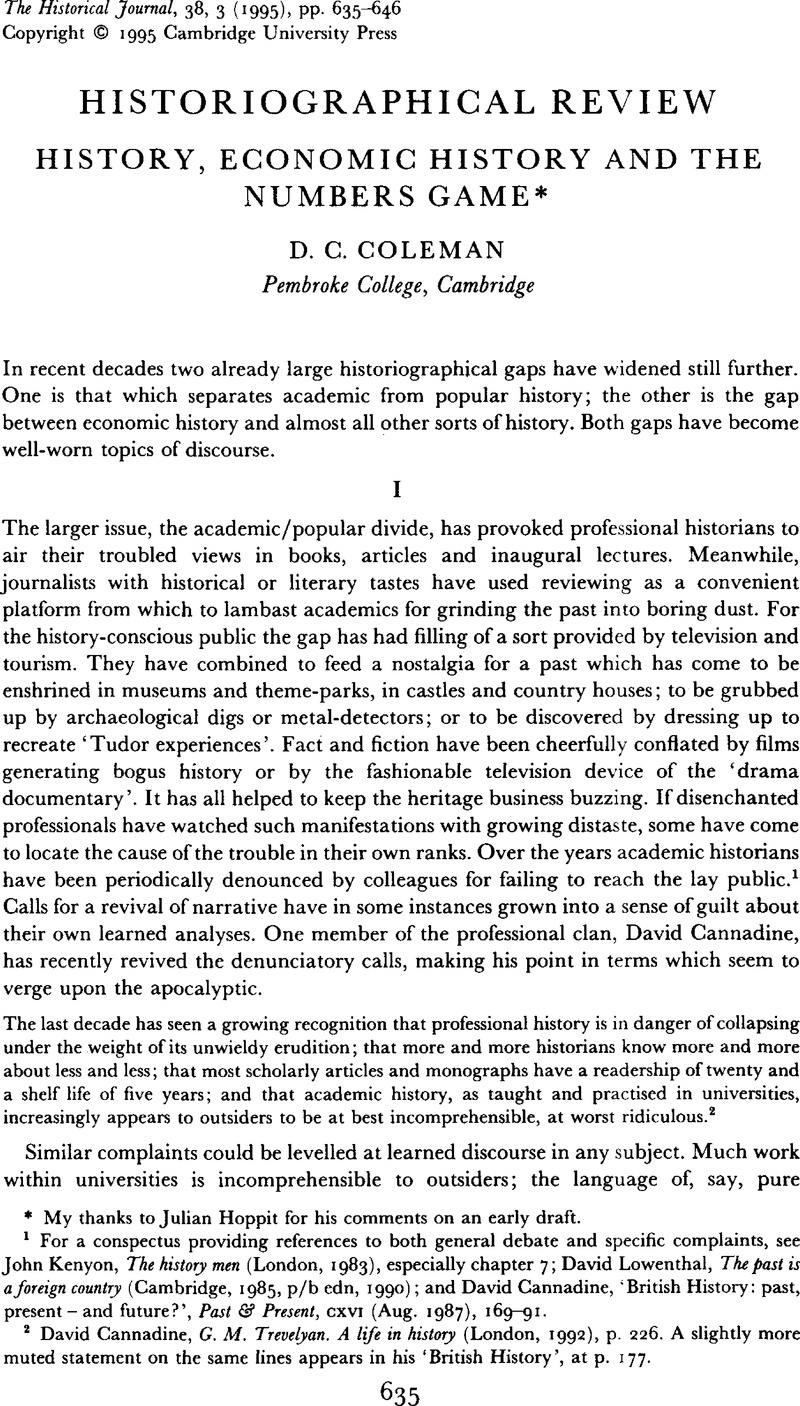Article contents
History, economic history and the numbers game*
Published online by Cambridge University Press: 11 February 2009
Abstract

- Type
- Historiographical Review
- Information
- Copyright
- Copyright © Cambridge University Press 1995
References
1 For a conspectus providing references to both general debate and specific complaints, see John, Kenyon, The history men (London, 1983), especially chapter 7Google Scholar; David, Lowenthal, The past is a foreign country (Cambridge, 1985, p/b edn, 1990)Google Scholar; and David, Cannadine, ‘British History: past, present – and future?’, Past & Present, CXVI (08. 1987), 169–91.Google Scholar
2 David, Cannadine, G. M. Trevelyan. A life in history (London, 1992), p. 226Google Scholar. A slightly more muted statement on the same lines appears in his ‘British History’, at p. 177.
3 Daunton, M. J., ‘What is economic history?’, in Juliet, Gardiner (ed.), What is history today (London, 1988)Google Scholar. The symposium first appeared in the magazine History Today between December 1984 and January 1986.
4 Cannadine, , ‘British History’, p. 186Google Scholar; Wilson, R. G. & Hadwin, J. F., ‘Economic and social history at advanced level’, Economic History Review, 2nd series XXXVIII (11. 1985), 566.Google Scholar
5 Cairncross, A. K., ‘In praise of economic history’, Economic History Review, 2nd series XLII (05 1989), 183.Google Scholar
6 Carlo, M. Cipolla, Between history and economics: an introduction to economic history (Oxford, 1991), p. 5.Google Scholar
7 Ibid. p. 74.
8 See Henry, Phelps Brown & Sheila, V. Hopkins, A perspective of wages and prices (London, 1981).Google Scholar
9 Fisher, H. A. L., A history of Europe (1936), preface, p. v.Google Scholar
10 Macaulay, T. B., History of England (1889 edn, 2 vols., London), I, 138.Google Scholar
11 Adam, Smith, Wealth of nations (1776, Modern Library edn, New York, 1937), p. 501.Google Scholar
12 William, Petty, Political arithmetic, preface, in Hull, C. H. (ed.), The economic writings of Sir William Petty (2 vols., Cambridge, 1899), I, 244.Google Scholar
13 Clapham, J. H., ‘The study of economic history’, in Harte, N. B. (ed.), The study of economic history (London, 1971), p. 68.Google Scholar
14 Clapham, J. H., An economic history of modem Britain (3 vols., Cambridge, 1939 edn), preface, I, vii.Google Scholar
15 The economic development of France and Germany 1815–1914 (Cambridge, 1921, 4th edn, 1936)Google Scholar; Concise economic history of Britain to 1750 (Cambridge, 1949).Google Scholar
16 Oxford, 1959.
17 Cambridge, 1962.
18 The work of both laureates ultimately rests upon that familiar figure of neo-classical economics, rational utility-maximizing man. But their labours have followed different paths. Fogel has deployed numerous mathematical calculations to elucidate such specific issues as railroads and slavery. North has widened out his work from the examination of productivity in eighteenth-century shipping to propounding theoretical explanations for the emergence over very long periods of history of such vast economic institutions as free markets and private property.
19 Donald, McCloskey, Enterprise and trade in Victorian Britain (London, 1981), pp. 25, 29, 31.Google Scholar
20 Attempts to measure the industrial revolution by putting numbers into a national accounting framework have produced a very partial picture of that unmeasurable metaphor. See Julian, Hoppit, ‘Counting the industrial revolution’, Economic History Review, 2nd series, XLIII (05 1990).Google Scholar
21 Lance, Davis, ‘“And it will never be literature”. The new economic history: a critique’, Explorations in entrepreneurial history, 2nd series, VI (1968).Google Scholar
22 McCloskey, , Enterprise and trade, p. 28.Google Scholar
23 Cairncross, , ‘In praise’, p. 175Google Scholar. Tawney's own view of these animals and of the interplay of history and theory would probably have been rather different. ‘There is no such thing as a science of economics nor ever will be’, he confided to his diary in 1913. Winter, J. M. & Joslin, D. M. (eds.), R. H. Tawney's commonplace book (Economic History Review Supplements, 5, Cambridge, 1972), p. 72.Google Scholar
24 Cairncross, loc. cit., p. 184.
25 Trevelyan, G. M., English social history (London, 1944), p. x.Google Scholar
26 Cannadine, , Trevelyan, p. 221.Google Scholar
27 Ibid. p. 184.
28 Ibid. p. 223.
29 Trevelyan, op. cit. pp. 400–1.
30 Ibid. p. 584.
31 Cipolla, loc. cit. p. 74.
32 Cairncross, loc. cit. p. 181.
33 Notably Strategy and structure (Cambridge, Mass., 1967)Google Scholar, The visible hand (Cambridge, Mass., 1977)Google Scholar and Scale and scope (Cambridge, Mass., 1990).Google Scholar
34 Elbaum, B. & Lazonick, W., The decline of the British economy (Oxford, 1986)Google Scholar; Coleman, D. C., Myth, history and the industrial revolution (London, 1992), pp. 1–42, 203–19.Google Scholar
35 Lazonick, W., Business organization and the myth of the market economy (Cambridge, 1991), especially pp. 147–9, 303–9.Google Scholar
- 3
- Cited by




